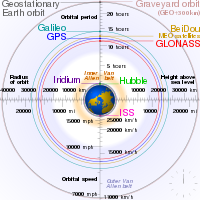
Photo from wikipedia
Abstract Satellite navigation constellations orbit the Earth in medium and geosynchronous orbits. Their high altitude provides wide coverage, which may be redundant if only regional coverage is needed. In this… Click to show full abstract
Abstract Satellite navigation constellations orbit the Earth in medium and geosynchronous orbits. Their high altitude provides wide coverage, which may be redundant if only regional coverage is needed. In this paper, a design scheme for regional navigation satellite constellations in low-Earth orbit is proposed. The design yields long coverage durations, which are characterized by a minimized Geometric Dilution of Precision (GDOP), with respect to a predefined mid-latitude receiver. The proposed constellations are defined for various combinations of the following parameters: Repeat Ground-Track commensurability, receiver latitude, number of satellites, and internal satellite arrangement. Optimal constellations, with respect to the GDOP integral, are searched, design guidelines are set up, and a mathematical model is fitted. The proposed constellations provide GDOP-optimized coverage durations, recurring twice each day. The results include numerical solutions for prograde near-polar constellations in altitudes ranging between 550 and 870 km, with receivers positioned at latitudes from 30° to 60°, and number of satellites ranging from 13 to 36. The average coverage duration varies from 20 to 80 min, with a mean GDOP ranging from 2.5 to 3.
Journal Title: Advances in Space Research
Year Published: 2019
Link to full text (if available)
Share on Social Media: Sign Up to like & get
recommendations!